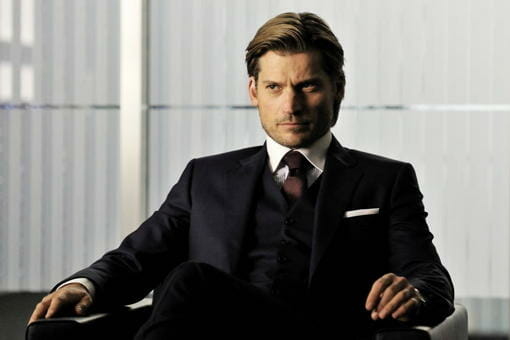By Pam Glazier · April 23, 2012

Headhunters, or Hodejegerne, is a new film by acclaimed Norwegian director Morten Tyldum. It’s based on the 2008 thriller novel of the same name by Jo Nesbø. It opens with Roger Brown (Aksel Hennie). Roger is Norway’s top “headhunter.” In other words, he’s the best of the best when it comes to hiring high profile types for mutli-national corporations. But Roger is also an art thief. Through small talk with the influential people he comes in to contact with, he learns what art they have and what their schedules are so that he can smoothly break in and replace their originals with forgeries. This allows him to shower his gorgeous wife with wealth and gifts. He explains that he must do this in order to compensate for the fact that he is far too short a man to be with so magnificent a creature.
But the bills are mounting up. What is poor Roger to do? for he mustn’t stop splurging on his wife. Luckily, this is where Roger meets Clas Greve (Nikolaj Coster-Waldau). Not only is Clas a very good looking candidate for the CEO position that Roger has been looking to fill, but he also happens to have a painting that could be worth up to 100,000,000 dollars. Never mind that Clas is a former mercenary, and never mind that his last job was for a firm that invented nanotechnology tracker chips—the job must be done.
What follows is a tense, nail-biting game of cat and mouse that goes way beyond what you would expect. I found myself constantly in disbelief at the stakes and how far things were going. This was pretty refreshing actually. It was a sort of palate cleanser from all the schlocky Hollywood thriller conventions that have become so very predictable.
But this film was not without its flaws. It begins by establishing Roger as an excellent headhunter and art thief who has constructed the perfect life, but this establishment is rushed so that we can get to the action of the heist and subsequent chase. Roger’s “normal” life seems completely removed from his thieving world, which takes up the main part of the film. And that makes some of his more over the top decisions a bit unbelievable. Especially since he completely missed that he was getting himself into massive danger by taking on this job, despite the fact that in the beginning he was characterized as being so calculating and ahead of the game.
And at the very end, during the denouement, the film completely changes tone. There was a tense undercurrent of life and death that ran through the whole thing until we see the final results. Then there is a strange sort of homage to Soderbergh’s Ocean’s movies. The score changes to an obviously kitschy Vegas pop, and there is a lot of slo-mo camera work and character glad-handing.
These disjointed oddities described above made the movie, well, a little disjointed. Of course, the film was still very enjoyable. But parts of it just felt a little wonky. Perhaps it was this wonkiness that added to the fresh quality of this film. Perhaps I cannot whine about the disjointed nature of this film while also praising its snubbing of convention. Perhaps it wanted me to feel disjointed, so I would feel just like Roger felt.
Then again, maybe the weirdness I’m experiencing comes from the fact that this film was adapted from a novel. Adaptations can be tricky as you have to fit it all in, be true to the voice, and yet be original while also conforming to structure norms. If the novel was a bit on the avant-garde side, that would explain the structure issues.
But it does not matter what the facts of these technical details are, this movie was pretty darned good. I would pay to see it again. The acting was magnificent, the scenes were sharp and kept me on the edge of my seat, and even the visual design was in keeping with the tone. I highly recommend it.